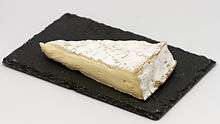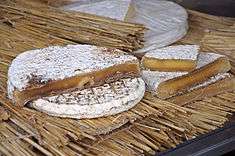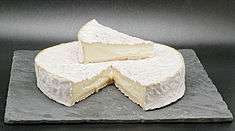Brie
| Brie | |
|---|---|
 | |
| Country of origin | France |
| Region, town | Seine-et-Marne |
| Town | Brie |
| Source of milk | Cows |
| Pasteurized | By law in the US and Australia, not in most of Europe |
| Texture | Soft-ripened |
| Aging time | Generally 5 to 6 weeks |
| Certification | AOC, 1980, for both Brie de Meaux and Brie de Melun |
|
| |
Brie (/briː/; French: [bʁi]) is a soft cow's-milk cheese named after Brie, the French region from which it originated (roughly corresponding to the modern département of Seine-et-Marne). It is pale in color with a slight grayish tinge under a rind of white mould. The rind is typically eaten, with its flavor depending largely upon the ingredients used and its manufacturing environment.
Production

Brie may be produced from whole or semi-skimmed milk. The curd is obtained by adding rennet to raw milk and warming it to a maximum temperature of 37 °C (99 °F). The cheese is then cast into molds, sometimes with a traditional perforated ladle called a pelle à brie. The 20 cm (8 in) mold is filled with several thin layers of cheese and drained for approximately 18 hours. The cheese is then taken out of the molds, salted, inoculated with cheese culture (Penicillium candidum, Penicillium camemberti) or Brevibacterium linens, and aged in a controlled environment for at least four or five weeks.
If left to mature for longer, typically several months to a year, the cheese becomes stronger in flavor and taste, the pâte drier and darker, and the rind also darker and crumbly, and it is called Brie Noir (French for "black brie"). Around the Île-de-France where brie is made, people enjoy soaking this in café au lait and eating it for breakfast.[1]
Overripe brie contains an unpleasant excessive amount of ammonia, produced by the same microorganisms required for ripening.[2]
Nutrition
A thirty-gram serving of brie contains 101 calories (420 kJ) and 8.4 grams of fat, of which 5.2 grams are saturated fat. Brie is a good source of protein; a serving of brie can provide 5 to 6 grams of protein. Brie contains a good amount of both vitamin B12 and vitamin B2. [5]
Varieties
There are now many varieties of brie made all over the world, including plain brie, herbed varieties, double and triple brie and versions of brie made with other types of milk. Indeed, although brie is a French cheese, it is possible to obtain Somerset and Wisconsin brie. Despite the variety of bries, the French government officially certifies only two types of cheese to be sold under that name: Brie de Meaux and Brie de Melun.
Brie de Meaux
Brie de Meaux is an unpasteurized brie, with an average weight of 2.8 kg (6.2 lb) for a diameter of 36 to 37 cm (14 to 15 in). Manufactured in the town of Meaux in the Brie region of northern France since the 8th century, it was originally known as the "King's Cheese", or, after the French Revolution, the "King of Cheeses," and was enjoyed by the peasantry and nobility alike. It was granted the protection of Appellation d'origine contrôlée (AOC) status in 1980, and it is produced primarily in the eastern part of the Parisian basin.
Brie de Melun

This brie has an average weight of 1.5 kilograms (3.3 lb) and a diameter of 27 cm (11 in).[6] It is therefore smaller than Brie de Meaux but is considered to have a stronger flavor and more pungent smell. It is made with unpasteurized milk. Brie de Melun is also available in the form of "Old Brie" or black brie. It was granted the protection of AOC status in 1980.
French non-AOC bries
The following French bries do not have AOC certification: Brie de Montereau, Île-de-France, Brie de Nangis, Brie de Provins, Brie noir, Brie fermier, Brie d'Isigny, Brie de Melun bleu, Brie petit moulé, Brie laitier Coulommiers.
International bries
Australia King Island Dairy, on King Island between Victoria and Tasmania, produces a range of cheeses sold as "brie",[7] as does Jindi Cheese in Victoria and the highly regarded High Valley Mudgee Cheese Co in Mudgee, NSW.[8]
UK Cornish Brie; Somerset Brie; Baron Bigod (made in Suffolk); Canarth Brie (made in Wales); Clava Brie[9] (made in Scotland).
US The Marin French Cheese Company in California has made an unaged cheese since 1865 described as "fresh brie".
Brazil Brazilian "brie" is made in the dairy region located in the Southern area of Minas Gerais state (bordering São Paulo and Rio de Janeiro states) and Southeast Minas Gerais (bordering Rio de Janeiro and Espírito Santo states).
Serving
Brie is usually purchased either in a full wheel or as a wheel segment.[10] The white outside of the cheese is completely edible, and many eat brie whole.[11] The cheese is sometimes served slightly melted or baked, in a round, lidded ceramic dish, and topped with nuts or fruit.
Storage
Brie cheese, like Camembert and Cirrus, is considered a soft cheese.[12] This particular type of cheese is very rich and creamy, unlike Cheddar. This softness allows for the rapid widespread growth of bacteria if the cheese is not stored correctly. It is recommended that brie cheese be refrigerated immediately after purchase, and stored in the refrigerator until it is consumed completely.[13] The optimal storage temperature for brie is 4 °C (39 °F) or even lower. The cheese should be kept in a tightly sealed container or plastic wrap to avoid contact with moisture and food-spoilage bacteria which will reduce the shelf life and freshness of the product.[13] The companies that produce this cheese usually recommend that their cheese be consumed before the best-before date and no later than a week after. Although the cheese can still be consumed at this time, the quality of the cheese is believed to be reduced substantially. In the case that blue or green mold appears to be growing on the cheese, it must no longer be consumed and must be discarded immediately so that food-borne illness is prevented. The mold should not be cut off to continue consumption as there is a high risk of the mold's spores being already spread throughout the entire cheese.[13]
Comparison with Camembert
Camembert is a similar soft cheese which is also made from cow's milk. However, there are differences such as its origin, typical market shape, size, and flavour. Brie originates from the Île-de-France while camembert comes from Normandy.[14] Traditionally, brie was produced in large wheels, 23 to 37 cm (9 to 14.5 in) in diameter, and thus ripened more slowly than the smaller camembert cheeses. When sold, brie segments typically have been cut from the larger wheels (although some brie is sold as small, flat cylinders), and therefore its sides are not covered by the rind. By contrast, camembert is ripened as a small round cheese 10 cm (4 in) in diameter by about 3 cm (1.25 in) thick and fully covered by rind. This ratio change between rind and paste makes camembert slightly stronger when compared to a brie ripened for the same amount of time. Once the rind is cut on camembert, the cheese typically has a more pungent aroma than does brie. In terms of taste, camembert has a stronger, slightly sour, and sometimes chalky taste. The texture of camembert is softer than that of brie, and if warmed, camembert will become creamier, whereas brie warms without losing as much structure.
References
- ↑ Masui, T.; Tomoko, Y.; Hodgson, R.; Robuchon, J. (2004). French Cheeses. DK. ISBN 1-4053-0666-1.
- ↑ McGee, Harold (2004). On Food and Cooking: The Science and Lore of the Kitchen. New York: Simon & Schuster. ISBN 0-684-80001-2.
- ↑ The New Irish Table: 70 Contemporary Recipes – Margaret M. Johnson. p. 17.
- ↑ "Footprint Ireland". google.com.
- ↑ Wolf, Nicki. "Nutritional Content of Brie Cheese". LIVESTRONG.COM. Retrieved 2018-06-10.
- ↑ Dixon, Peter. "Dairy Foods Consulting & Westminster Artisan Cheesemaking". Archived from the original on 27 December 2013. Retrieved 25 July 2013.
- ↑ King Island Dairy King Island Dairy – Soft White Retrieved March 8, 2015
- ↑ Jindi Cheese website Jindi Cheese : White Cheese Range Retrieved March 8, 2015
- ↑ "Scottish Cheese and Cheese Makers". Taste of Scotland. Retrieved 2018-04-13.
- ↑ Androuët, P. (1997). Le brie. Presses du Village. ISBN 978-88-15-06225-3.
- ↑ Benêt, J. (2005). Histoire du fromage de Langres. Broché. ISBN 978-2-87825-332-0.
- ↑ "Cheeses by texture – Cheese.com". cheese.com.
- 1 2 3 "How Long Does Soft Cheese Last? Shelf Life, Storage, Expiry". Eat By Date.
- ↑ Foster, Kelli (February 24, 2015). "What's the Difference Between Brie and Camembert?". The Kitchn. Retrieved April 28, 2017.
External links
